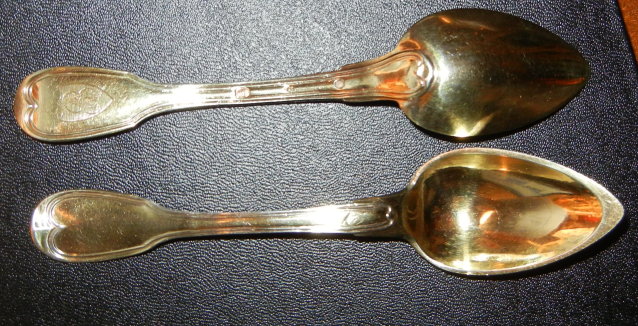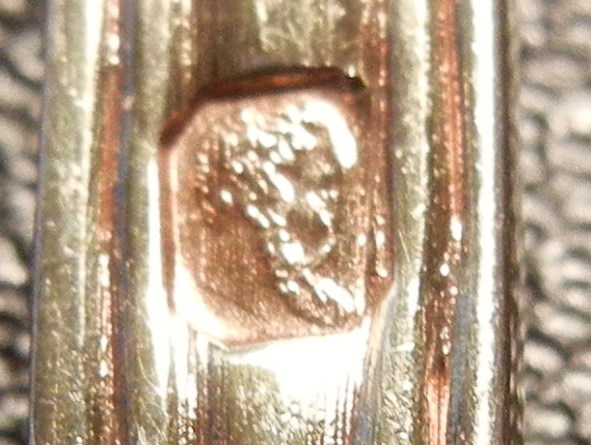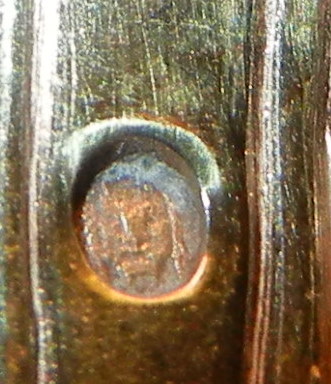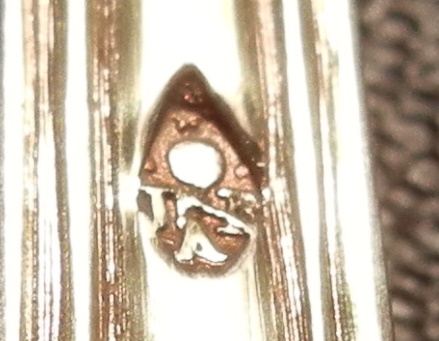|
|
|
| How to Post Photos |
REGISTER (click here)
|
|
|
|
| How to Post Photos |
REGISTER (click here)
|

|
 SMP Silver Salon Forums SMP Silver Salon Forums
  Continental / International Silver Continental / International Silver
  French Thread teaspoons French Thread teaspoons
|
| next newest topic | next oldest topic |
| Author | Topic: French Thread teaspoons |
|
ahwt Posts: 2334 |
  
    The first picture above shows the front and back of two French thread teaspoons with Paris hallmarks used from 16 August 1819 to 10 May 1838. The second picture from the top shows the profile of a bearded man with the number 1 slightly to the right of his mouth representing 950 silver. The next picture is the Paris hallmark for “meiun objects”. I am not sure what this picture represents over and above the meaning of the first hallmark. This mark does have on the reverse the Bigorne mark while the profile of the man does not have any mark on the reverse. The last picture is the makers mark and that appears to me to be J B over A and this I believe in the French system stands for the initials JBA. All the spoons have a gold wash and have an attractive monogram on the reverse within a shield symbol. Each spoon has a different insect. My questions are why put two hallmarks on the spoons and why would only one of the hallmarks have the Bigorne mark on its reverse. IP: Logged |
|
Kayvee Posts: 204 |
  
Well those French marks can be mystifying, especially in the post-Revolutionary period from 1798 until 1838 when the marking system changed every ten years or so. The Michelangelo head facing right in an octagonal reserve is the silver standard or assay mark (poinçon de titre) for Paris used from 1819-1838 for 950 silver. The Gorgon head mark in a circular reserve is a guarantee mark (poinçon de garantie) used to complement the Michelangelo mark. Its purpose was to guarantee that the maker had paid tax on the object and to guarantee that there had been no collusion between the assayer and the tax collector. The guarantee mark was an administrative mark replacing the charge and discharge marks used in pre-Revolutionary times. This mark was struck using a bigorne as an added assurance for the consumer. Don’t forget that the guilds had been suppressed after the Revolution, and silver makers were intent on maintaining consumer confidence. Finally the maker’s mark in a lozenge-shaped reserve is that of Jean-Baptiste Andrieu, a Parisian flatware maker working at 24 Place Dauphine from 1820 until his death in 1830. His widow continued the business using another mark. Hopes this helps to clarify the French marking system in use from 1819-1838. [This message has been edited by Kayvee (edited 01-09-2011).] IP: Logged |
|
ahwt Posts: 2334 |
  
Thank you Kayvee. You made it seem so simple. I have always liked and collected the fiddle/French thread pattern. The French, I believe, invented this pattern. For some reason the English and the Americans did not use the sloping shoulders or the extended shelf around the bowl and that I think was a mistake.
IP: Logged |
|
Kayvee Posts: 204 |
  
You are very welcome. I’m with you on the Thread pattern. The French don’t call it Fiddle/Thread unless the terminal end is waisted. The pattern first appeared in France at the end of the 17th Century. I’ve heard that shoulders developed as reinforcement for spoons and forks at their weakest point, weakness that was increased by chasing in of the Thread motif. Spoons with an elongated, more pointed bowl first appeared in France in the early 19th Century. How long are your spoons? If they are 16-17 cm long, and are gilt, they are probably dessert spoons. IP: Logged |
|
ahwt Posts: 2334 |
  
The eleven spoons (I suspect a family member kept one as a remembrance) we brought are 13.6 cm long – a little longer than demitasse and a little shorter than a regular teaspoon. We do not have any other spoons with the vermeil finish and these will be fun to use with some kind of dessert even if they are not quite the right length. We had a great flan this weekend in Atlanta and I think they would be great with that dessert. The gold color on these spoons is softer that other gold washes that I have seen. Maybe it is just the age or maybe the silversmith used a different process to coat the silver. IP: Logged |
|
Kayvee Posts: 204 |
  
I'm of the use your silver persuasion, so it is great to know that you're enjoying the spoons even if they aren't official dessert spoons. The gilding makes them ideal for any custard-type dessert. IP: Logged |
|
Marc Posts: 414 |
  
Hi there AWHT, Warmness of gold color is because of method of applying the gold. Fire guilding was done at the time your pieces were made.. Electroplating came along later, like in the 2nd quarter of the 19th century. IP: Logged |
|
denimrs Posts: 102 |
  
How lovely this spoon is. The gold wash is beautiful and I am not normally inclined to like vermeil, preferring the pure silver color. The sharp point on the bowl makes me wonder if it may have been intended for some specific use, such as eating grapefruit? And, the gold wash makes me wonder if it might have been intended for boiled egg? Did the French make items for such uses? At that time? Or, maybe Kayvee has hit on something with the notion of using them for custard. Maybe they were intended as custard spoons? Perhaps even for creme brulee, with the point there to break the top? IP: Logged |
|
Kayvee Posts: 204 |
  
I believe that the length of these spoons tells us that they are coffee spoons. An egg spoon would be shorter. The elongated oval bowl with pointed end is stylistic, not functional. This style first appeared in France in the early 19th C. For example, all the spoons that Biennais made for Napoleon and his entourage had this bowl shape. By the 1840's, the pointed bowls had all but disappeared. How wonderful that whatever their original use, someone is still enjoying them today. IP: Logged |
|
blakstone Posts: 493 |
  
I wouldn't read too much into the pointed bowl; this was a stylistic affectation pretty much common to French (and some other European) spoons of all sizes in the 1830's & 40's. I have a couple of nice gilded sets like this, and I see no reason to think they are anything other than very nice sets of teaspoons. But, then as now, they were probably put into service as dessert spoons as needed. Thanks for sharing them! IP: Logged |
|
ahwt Posts: 2334 |
  
Thanks for all your comments. The pointed bowl style was used occasionally on American silver, but as I recall, only after the 1840s. That would probably reflect the time delay in the way styles came to the U.S. from overseas. IP: Logged |
All times are ET | next newest topic | next oldest topic |
  |
|
Ultimate Bulletin Board 5.46a
|
1. Public Silver Forums (open Free membership) - anyone with a valid e-mail address may register. Once you have received your Silver Salon Forum password, and then if you abide by the Silver Salon Forum Guidelines, you may start a thread or post a reply in the New Members' Forum. New Members who show a continued willingness to participate, to completely read and abide by the Guidelines will be allowed to post to the Member Public Forums. 2. Private Silver Salon Forums (invitational or $ donation membership) - The Private Silver Salon Forums require registration and special authorization to view, search, start a thread or to post a reply. Special authorization can be obtained in one of several ways: by Invitation; Annual $ Donation; or via Special Limited Membership. For more details click here (under development). 3. Administrative/Special Private Forums (special membership required) - These forums are reserved for special subjects or administrative discussion. These forums are not open to the public and require special authorization to view or post. |
|
copyright © 1993 - 2022
SM Publications
All Rights Reserved. Legal & Privacy Notices |